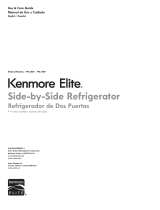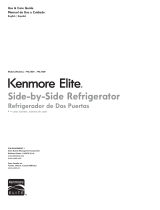
46
TROUBLESHOOTING
Problem Possible Causes Solutions
Interior moisture
buildup.
The doors are opened often or
for long periods of time.
When the doors are opened often or for long
periods of time, warm, humid air enters the
compartment. This raises the temperature and
moisture level within the compartment. To lessen
the eect, reduce the frequency and duration of
door openings.
The doors are not closed
correctly.
See the Doors will not close correctly section in
the Troubleshooting section.
The weather is humid. Humid weather allows additional moisture
to enter the compartments when the doors
are opened leading to condensation or frost.
Maintaining a reasonable level of humidity in the
home will help to control the amount of moisture
that can enter the compartments.
The defrost cycle recently
completed.
During the defrost cycle, the temperature of each
compartment may rise slightly and condensation
may form on the back wall. Wait 30 minutes and
conrm that the proper temperature has been
restored once the defrost cycle has completed.
Food is not packaged correctly. Food stored uncovered or unwrapped, and damp
containers can lead to moisture accumulation
within each compartment. Wipe all containers
dry and store food in sealed packaging to prevent
condensation and frost.
Food is freezing
in the refrigerator
compartment.
Food with high water content
was placed near an air vent.
Rearrange items with high water content away
from air vents.
The refrigerator temperature
control is set incorrectly.
If the temperature is too cold, adjust the control
one increment at a time and wait for the
temperature to stabilize. Refer to the Setting the
Controls section for more information.
The refrigerator is installed in a
cold location.
When the refrigerator is operated in temperature
below 41°F (5°C), food can freeze in the
refrigerator compartment. The refrigerator should
not be operated in temperatures below 55°F
(13°C).
Frost or ice
crystals form
on frozen food
(outside of
package).
The door is opened frequently
or for long periods of time.
When the doors are opened often or for long
periods of time, warm, humid air enters the
compartment. This raises the temperature and
moisture level within the compartment. Increased
moisture will lead to frost and condensation.
To lessen the eect, reduce the frequency and
duration of door openings.
The door is not closing properly. Refer to the Doors will not close correctly or pop
open section in the Troubleshooting section.
ENGLISH









